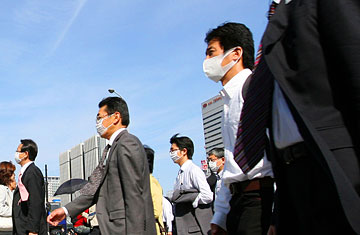
Commuters wear masks as precaution against swine flu in Osaka, Japan, on May 18, 2009
Panic over the threat of a global pandemic has subsided since early May, as governments around the world have stepped up preventive measures that seem to be keeping the virus under control. But Japan's weekend cases are not alone; by Sunday, the U.K. confirmed 14 more cases, while Turkey and India both announced their first, bringing the number of countries affected to 39. In Hong Kong, a 23-year-old student returning from North America became the territory's third swine flu case, and the 63 passengers who sat closest to him on his flight are being tracked by government officials to be quarantined for a week in a remote holiday camp in the region. In Beijing, a student recently returned from the U.S. video-chatted with Chinese Premier Wen Jiabao from her hospital bed after being confirmed as the mainland's third swine flu patient. (See pictures of the swine flu in Mexico.)
Authorities in East Asia — which has suffered heavily in recent years from outbreaks of various infectious diseases — have clamped down early and quickly on suspected cases of swine flu. Just over a week ago, Hong Kong released some 300 people stuck at a business hotel after cooping them up in a weeklong quarantine when one guest was found to be carrying the virus. The city, one of Asia's busiest business and travel hubs, was ravaged by the 2003 SARS epidemic as well as subsequent scares over avian flu. As a consequence, its counterpandemic procedures are among the most draconian in the world, while its epidemiology laboratories are among the most advanced. (Read "Battling Swine Flu: The Lessons from SARS.")
But the spike in Japan's cases shows that swine flu can infiltrate safety nets there and elsewhere, lingering beneath the radar of health monitors. Government officials are still unsure of how the virus reached Osaka and Hyogo, or how long it has been circulating in the region's highly populated urban centers of Osaka and Kobe. In addition to schools, movie theaters in the outbreak-hit prefectures were advised to close today, and Tokyo has blocked its own educational institutions from visiting the areas on field trips. "We must be prepared for a further expansion [of the virus]," says Toru Hashimoto, Osaka's governor.
Japan's four earlier suspected swine flu cases came from travelers inbound from North America, but this new bout appears to be wholly domestic. Most of the cases involve teenagers — the first confirmed infected on Saturday were high school students on a volleyball team — but those sick with the new strain of flu now range from 5 years old to 60. "It circulated silently, without anybody thinking of it," says Peter Cordingley, spokesman for the WHO in Manila. "The virus is highly transmittable, and signs of it breaking out of a contained area into the greater community must be watched and taken very seriously." (See the 5 things you need to know about swine flu.)
Swine flu's known symptoms vary little from those of winter flu, which is one of the main reasons it is difficult to track. Those with underlying health problems, such as diabetes or heart disease, seem especially vulnerable —a particular concern for a nation like Japan with a high elderly population. None of the infected are in critical condition, but, as deadly influenza pandemics have proved in the past, the current strain of H1N1 may mutate and become far more virulent — and lethal — by the next flu season. (Read "How to Deal with Swine Flu: Heeding the Mistakes of 1976.")
Seto Wing-hong, a leading microbiologist and a member of the Hong Kong government's Influenza Research and Response Group, is cautiously optimistic about the world's ability to reckon with this new disease. "There is every chance that it will spread," he says. "But these things have long incubation periods, and we, like never before, have the luxury of time and high-speed technology to track strains of viruses again and again and to fine-tune our actions in response." Seto believes a usable vaccine can be made and distributed by September or October.
Still, with the world economy so tightly integrated and millions on the move every day, the threat of an epidemic haunts the health officialdom of all governments. Kiyoshi Kurokawa, a public-health-policy expert and adviser to the Japanese Prime Minister, urges continuous communication among governments, hospitals dealing with outbreaks and international agencies. "Keeping the process transparent is key," he says. As Japan comes to grips with the virus in its midst, the enemy it — and the world — knows is far better than the one it does not.
— With reporting by Coco Masters / Tokyo
